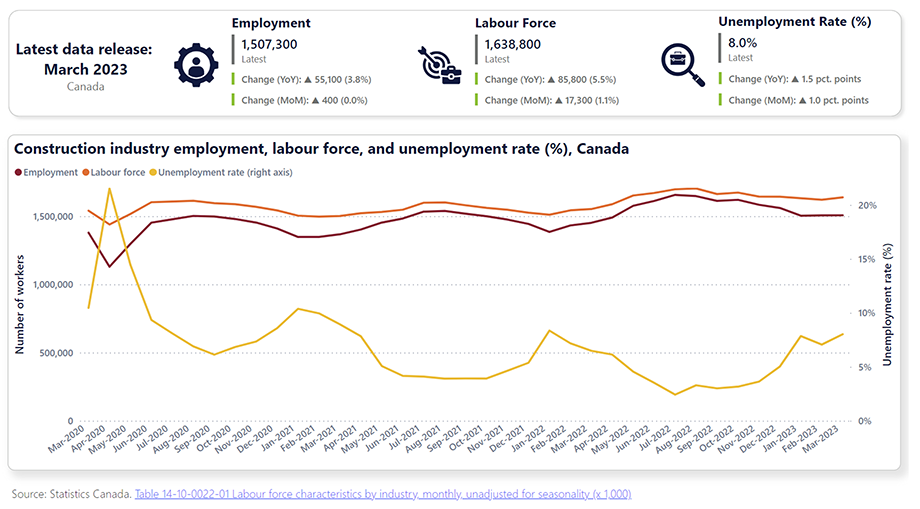Canada’s labour market continues to grow.
The latest Labour Force Survey data from Statistics Canada, for March 2023, shows that employment added 35,000 workers (+0.2%) in the month. This continues a general upward trend that began in September 2022. With strong gains reported in January (+150,000) and December (+69,000), the number of people employed across all industries has increased by 383,000 (+1.9%) in the past seven months.
The national unemployment rate, meanwhile, remained unchanged for the fourth consecutive month at 5%.
Employment increased in Ontario, Alberta, Manitoba, and Prince Edward Island, while it was stable in all other provinces but for Saskatchewan, where it declined by 0.7%. Total hours worked rose by 0.4% in March and were up 1.6% from the same period last year.
Statistics Canada collected data for this latest Labour Force Survey during the week of March 12 to 18.
Construction reports year-over-year gains
Construction sector employment also continues to rise.
Industry employment is 55,100 workers (+3.8%) higher than March 2022 levels. Overall, the industry employed a total of 1,507,300 Canadians. The industry’s labour force grew by 85,800 workers (+5.5%) over the same period, reaching a total of 1,638,800 workers. The unemployment rate, which is typically between 10% and 14% at this time of year, reached 8%.

Employment growth was largest in British Columbia (+24,700 workers; +11.1%), Manitoba (+4,600; +9.6%), Newfoundland and Labrador (+1,400; +8.7%), and Quebec (+18,800; +6.9%), although most provinces recorded positive growth on a year-over-year basis. Only Saskatchewan (-5,500; -11.9%) and Nova Scotia (-2,300; -5.9%) experienced contractions. Employment in Alberta was mostly unchanged. On a month-over-month basis, employment was almost unchanged across Canada. This is likely due to seasonal conditions.
Although sluggish at the beginning of 2022, labour force growth has been slowly catching up to employment growth.
In March, the construction labour force grew to 1,638,800 Canadians, an increase of 85,800 workers (+5.5%) from a year previous. The labour force grew in almost every province but for Saskatchewan (-13.9%), Prince Edward Island (-5.2%), Nova Scotia (-3.3%), and New Brunswick (-2.6%). British Columbia experienced the largest labour force increase at 12.7%, followed by Quebec and Manitoba at just over 8%. Ontario’s labour force grew at 5.4% and Alberta’s by 1.9%.
On a monthly basis, the national construction labour force grew by 17,300 workers (+1.1%). Ontario’s labour force added 20,300 workers (+3.4%) and accounted for the largest monthly gain. Alberta followed at 4,300 workers (+1.8%), while Quebec (-6,000 workers; -1.9%) reported the largest absolute contraction.
Construction sector unemployment rates came in higher than the previous year for the first time since February 2021. While year-over-year growth in employment was robust, 2023 presented the highest growth in the labour force for the month of March in 10 years.
The strong growth in Canada’s construction labour force is at least in part driven by an increase in the number of women joining the industry – coinciding with rising apprenticeship registrations between 2017 and 2019.
In March, the number of women in the construction labour force grew by 29,600 workers, accounting for 34% of overall labour force growth. By comparison, women have, on average, accounted for 18% of labour force growth in Canada’s construction industry for the last 20 years (for the month of March only).


Construction Key Indicators
